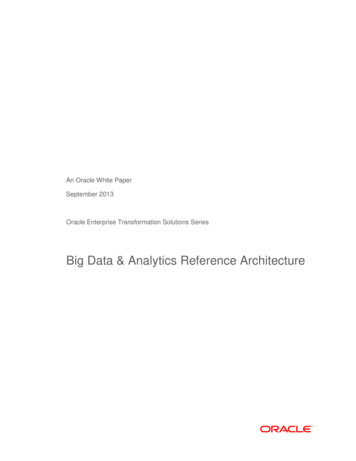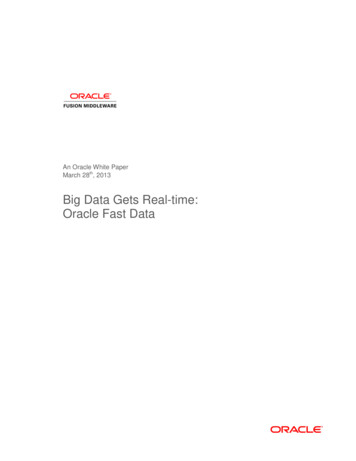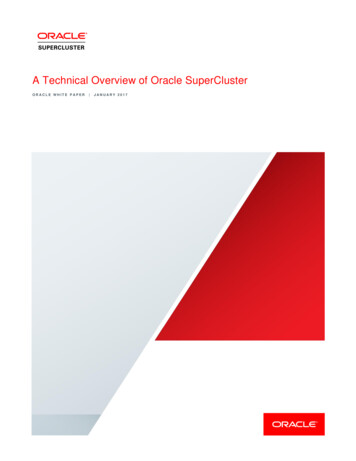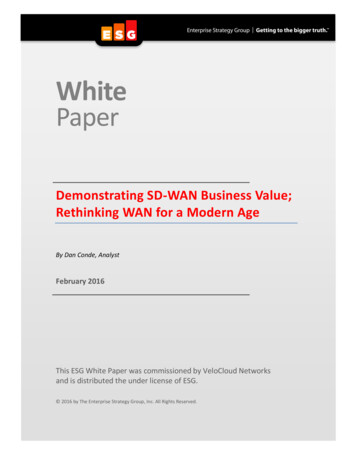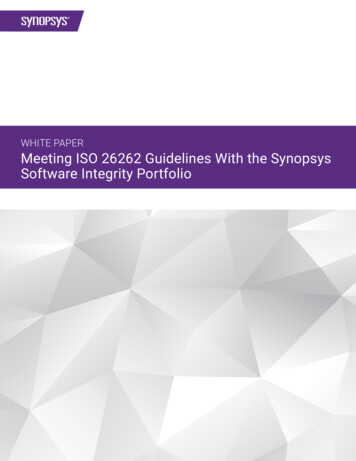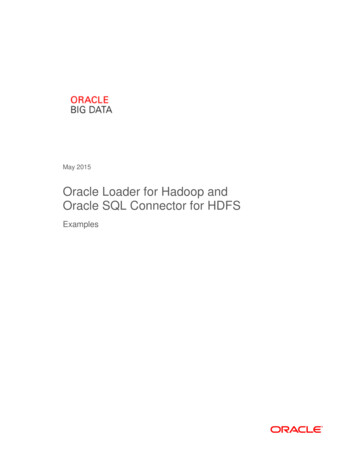
Transcription
May 2015Oracle Loader for Hadoop andOracle SQL Connector for HDFSExamples
Oracle Loader for Hadoop and Oracle SQL Connector for HDFS ExamplesExamples . 0Introduction . 1Oracle SQL Connector for HDFS . 1Oracle Loader for Hadoop . 2Framework . 3Acronyms . 3Examples . 3Product Installation . 3Setup and Cleanup . 5Cleanup for Re-run . 5Definition of Terms . 6Part 1: Oracle SQL Connector for HDFS . 6Specifying Hive Table Partitions . 7Using the Connector . 7Part 1a: Accessing Files on HDFS with Oracle SQL Connector for HDFS 8Part 1b: Accessing Hive Tables with Oracle SQL Connector for HDFS9Access data in a non-partitioned Hive table from Oracle Database 9Part 1c: Accessing Hive Tables with Oracle SQL Connector for HDFS11Access Select Hive Partitions from a Partitioned Hive Table . 11Populate an Oracle Database table . 13Partition Pruning with an UNION ALL view . 13Part 1d: Performance Tuning for Oracle SQL Connector for HDFS . 14Part 2: Oracle Loader for Hadoop . 17Part 2a: Load delimited text files in HDFS with Oracle Loader for Hadoop 17Part 2b: Load Hive tables with Oracle Loader for Hadoop . 18Part 2c: Load from Apache Log Files Oracle Loader for Hadoop . 20Conclusion . 21
Oracle Loader for Hadoop and Oracle SQL Connector for HDFS ExamplesIntroductionOracle Loader for Hadoop and Oracle SQL Connector for Hadoop Distributed File System(HDFS) enable high performance load and access of data from a Hadoop platform to OracleDatabase. These efficient connectors, optimized for Hadoop and Oracle Database, make iteasy to acquire and organize unstructured data on Hadoop and bring it together with data inOracle Database, so that applications can analyze all data in the enterprise.This document describes examples to work with Oracle Loader for Hadoop and Oracle SQLConnector for HDFS. It accompanies a kit that contains the examples and sample data.Oracle SQL Connector for HDFSOracle SQL Connector for HDFS uses external tables to provide Oracle Database with readaccess to Hive tables, delimited text files, and Oracle Data Pump files on Hadoop clusters. Autility available with Oracle SQL Connector for HDFS generates an external table for data onHadoop. Oracle SQL can then be used to query this external table and load data from thistable into the database. The data is accessed and loaded in parallel for very high speed loadinto the database.1
Oracle Loader for Hadoop and Oracle SQL Connector for HDFS ExamplesOracle Loader for HadoopOracle Loader for Hadoop is an efficient and high-performance loader for fast movement ofdata from a Hadoop cluster into Oracle database. It pre-processes the data on Hadoop tooptimize the load. The pre-processing includes partitioning the data by partition key, sortingthe data, and transforming it into a database-ready format. Performing these operations onHadoop leverages the parallel processing framework of Hadoop to perform operations typicallyperformed on the database server as part of the load process. Offloading the operations toHadoop reduces the CPU requirements on the database server, thereby lessening theperformance impact on other database tasks.2
Oracle Loader for Hadoop and Oracle SQL Connector for HDFS ExamplesFrameworkAcronymsOLH: Oracle Loader for HadoopOSCH: Oracle SQL Connector for Hadoop Distributed File System (HDFS)Operating system prompts are represented in this document as ‘prompt ’SQL*Plus prompts are represented in this document as ‘SQL ’ExamplesPart 1. Part 1 contains examples with Oracle SQL Connector for HDFS. Use Oracle SQL Connector for HDFS to query text files in-place in HDFS Use Oracle SQL Connector for HDFS to query data in Hive Use Oracle SQL Connector for HDFS query select Hive partitions Illustrate performance tuning with Oracle SQL Connector for HDFSPart 2. Part 2 contains examples with Oracle Loader for Hadoop. Use Oracle Loader for Hadoop to load data from delimited text files in HDFS into OracleDatabase Use Oracle Loader for Hadoop to load data from Hive tables into Oracle Database Use Oracle Loader for Hadoop to load data from Apache log files in HDFS into OracleDatabaseProduct InstallationThese examples work with the Oracle Big Data Lite VM, which has installed versions of Oracle Loaderfor Hadoop and Oracle SQL Connector for HDFS. If you are using this VM you can skip the rest ofthis section.If you would like to use the examples in your own environment, below are the Hadoop and OracleDatabase versions to use, the download locations for the products, and environment variables.Hadoop and Hive VersionsThe Hadoop and Hive versions on your cluster should be: Hadoop: A distribution based on Apache Hadoop 2.x (certified Hadoop distributions arelisted here). Hive: 010.0 or aboveContact us if you are interested in using the connectors but would like to use a distribution that is notyet certified.3
Oracle Loader for Hadoop and Oracle SQL Connector for HDFS ExamplesOracle DatabaseInstall Oracle Database 11.2.0.3 or higher. Oracle Database 12.1.0.2 is available for download at theOracle Technology Network. Contact us if you need help.Oracle Loader for HadoopDownload the kit from the Oracle Technology Network tmlUse Oracle Loader for Hadoop 3.0 or higher.See Section 1.5 in the Oracle Big Data Connectors User’s Guide for installation instructions, followlinks from -appliance/documentation/bigdata1454976.htmlAs described in the documentation this is installed on a node from which you submit MapReduce jobs.Oracle SQL Connector for HDFSDownload the kit from the Oracle Technology Network tmlUse Oracle SQL Connector for HDFS 3.0 or higher.See Section 1.4 in the Oracle Big Data Connectors User’s Guide for installation instructions, followlinks from -appliance/documentation/bigdata1454976.htmlAs described in the documentation, Oracle SQL Connector for HDFS must be installed andconfigured on the database node. Additionally, it is recommended that you install and configureOracle SQL Connector for HDFS on a system configured as Hadoop client. This is necessary ifaccessing Hive tables.Also as described in the documentation, a Hadoop client (minimally the HDFS client) has to beinstalled on the database node.Set Required Environment VariablesThe following environment variables are required. These are described in the installation instructionsin the Oracle Big Data Connectors User’s Guide, they are repeated here for emphasis.For Oracle Loader for Hadoop, in the Hadoop node environment (where you will submit OracleLoader for Hadoop jobs):#Set OLH HOME to the directory where Oracle Loader for Hadoop is installed.For example, set OLH HOME to /u01/connector/loader/oraloader-3.3.0-h2(Change version number depending on your installation)4
Oracle Loader for Hadoop and Oracle SQL Connector for HDFS Examples##Add to HADOOP CLASSPATH {OLH HOME}/jlib/*For Oracle SQL Connector for HDFS, in the Hadoop node environment and the database nodeenvironment:#Set OSCH HOME to the directory where Oracle SQL Connector for HDFS is installed.For example, set OSCH HOME to /u01/connector/hdfs/orahdfs-3.2.0(Change version number depending on your installation)##Add to HADOOP CLASSPATH {OSCH HOME}/jlib/*## If accessing Hive Tables using OLH and OSCH, also add the following toHADOOP CLASSPATH {HIVE HOME}/lib/* {HIVE HOME}/confSetup and CleanupExamples Scripts and DataThe kit contains setup scripts, example scripts, and sample data. In the Big Data Lite VM unzipexample scripts.zip to /home/oracle/movie/moviework. This will contain osch/,olh/, data/ and setup/ directories. Setup and reset scripts are located in setup/Data files are located in data/All examples for Oracle SQL Connector for HDFS are located in osch/All examples for Oracle Loader for Hadoop are located in olh/Note: If you are not using the VM, then you should edit the examples accordingly to change NFSlocation, HDFS directory, and database connection information.Cleanup for Re-runExample scripts can be repeated by cleaning up directories and files from previous runs by runningreset conn.sh.Ignore warning and error messages while running this script. They are messages indicating an objectdoes not exist (which would be the case if an example has not been run).5
Oracle Loader for Hadoop and Oracle SQL Connector for HDFS ExamplesDataThere are five data files in the HDFS directory /user/oracle/data. The data contains data oftype string, integer, float, and date. A sample from file part-00002 is below:1084372 1661782012-10-01:01:29:340111191532 59440302012-10-01:01:30:27141106264 28182012-10-01:01:35:191111061810 12172012-10-01:01:56:421111135508 24082012-10-01:01:58:00121135508 24082012-10-01:02:04:15151135508 1092202012-10-01:02:10:23051135508 24082012-10-01:02:31:121111191532 59440302012-10-01:03:11:35121191532 The blank values are NULL.)Definition of TermsConfiguration parameters: These properties are used by the connectors during execution of OracleSQL Connector for HDFS and Oracle Loader for Hadoop. They can be specified in an XML file oron the command line (using -D). Examples of configuration parameters are the locations of data files,database connection information, table name, schema name, and so on.Location files: Location files are part of the LOCATION clause in an external table definition.These files are populated by Oracle SQL Connector for HDFS and will contain URIs of the data fileson HDFS.Part 1: Oracle SQL Connector for HDFSOracle SQL Connector for HDFS enables Oracle SQL access to data in Hadoop, via external tables.The data can be in a Hive table, text files in HDFS, or Oracle Data Pump files on HDFS.Oracle SQL Connector for HDFS creates database objects to access data in Hadoop. Querying theseobjects will access data in Hadoop. When the data is in text files, non-partitioned Hive tables andOracle Data Pump files, Oracle SQL Connector for HDFS creates a single external table to access thedata. When the data is in partitioned Hive tables Oracle SQL Connector for HDFS creates multipledatabase objects - one external table and one database view for each partition. The external tables map6
Oracle Loader for Hadoop and Oracle SQL Connector for HDFS Examplesto the data columns in the Hive table (without the partition column values), and database views map tothe data columns plus the partition column values. An application will use external tables to query textfiles, non-partitioned Hive tables and Oracle Data Pump files, and database views to query partitionedHive tables.External tables and views can be queried with full Oracle SQL functionality. They cannot be updated.There are performance speedups while querying a Hive partitioned table since only the requiredpartitions are queried. For example, consider a Hive table containing monthly sales data partitionedby date. An application that needs sales data for the 15th can query the view that corresponds to thatpartition.ExampleA Hive table is a monthly sales table partitioned by date. There are 30 partitions in the Hive table, onefor each day in the month.Oracle SQL Connector for HDFS will create 30 external tables and 30 database views, one for eachpartition. It will also create a metadata table that contains information about the external tables andviews to identify which view to query.LoadOracle SQL can be used to query the external table or database view and insert into tables in thedatabase for high speed load.Specifying Hive Table PartitionsExternal tables and views are created for only selected partitions.Partitions of interest are specified using a HiveQL predicate using the propertyoracle.hadoop.exttab.partitionFilter. Note that the predicate can only containpartition columns. Predicates with other column values are not supported, and can result inunexpected results.When this property is not specified external tables and views are created for all partitions of the Hivetable.Using the ConnectorThere are two steps while using this connector.7-The command-line tool creates the database objects. This step needs access to HDFS and ifaccessing Hive tables, to the Hive metastore. So it is recommended to run this step on aHadoop node. (If HDFS and Hive clients are installed on the database node then this stepcan be run on that node if necessary.)-Querying data from the database, by querying the created database objects with Oracle SQL.
Oracle Loader for Hadoop and Oracle SQL Connector for HDFS ExamplesPart 1a: Accessing Files on HDFS with Oracle SQL Connector forHDFSIn this section we access text data files in HDFS from Oracle Database via external tables. The VM issingle-node, so both Hadoop and Oracle Database are on the same node. In a multi-node system youwill run Step 1 on Hadoop, and Step 2 (querying the data) from Oracle Database.Step 1: Create the external table in Oracle Database to access files in HDFS.prompt cd /home/oracle/movie/moviework/oschExecute the script:prompt sh genloc moviefact text.shYou will be prompted for the password for moviedemo (this is welcome1).or (run the script directly from the command line):prompt hadoop jar OSCH HOME/jlib/orahdfs.jar \oracle.hadoop.exttab.ExternalTable \-conf /home/oracle/movie/moviework/osch/moviefact text.xml\-createTableStep 2: From the databaseYou can see the external table definition from the output on screen, and also the contents of thelocation files. The location files contain the URIs of the data files in HDFS.The data can now be queried by the database via the external table.You can also look at the external table definition in SQLPlus:prompt sqlplus moviedemo@orcl/welcome1SQL describe movie fact ext tab file;You can try some queries on this external table, which will query data in the files.prompt sqlplus moviedemo@orcl/welcome1SQL select count(*) from movie fact ext tab file;COUNT(*)---------3000258
Oracle Loader for Hadoop and Oracle SQL Connector for HDFS ExamplesSQL select cust id from movie fact ext tab file where rownum 10;You can try joining this table with tables in Oracle Database.Notes:This example used Oracle SQL Connector for HDFS with the –createTable option. This createsthe external table and populates the location files in the external table LOCATION clause with theURIs of the data files on HDFS.Take a look at the configuration parameters in moviefact text.xml.prompt more moviefact text.xmlSome of the parameters are:oThe name of the table that we want to create in Oracle Database to access the files on HDFSoSchema containing the tableoLocation of the data files in HDFSoDatabase connection informationolocationFileCount 2ooracle.hadoop.exttab.sourceType textooracle.hadoop.exttab.columnNames (a list of column names the external tableshould use)Part 1b: Accessing Hive Tables with Oracle SQL Connector forHDFSAccess data in a non-partitioned Hive table from Oracle DatabaseThis example uses a Hive table created as part of the setup.Step 1: Creates the external table in Oracle Database to access this Hive tableprompt cd /home/oracle/movie/moviework/oschExecute the script:prompt sh genloc moviefact hive.shYou will be prompted for the password for moviedemo (this is welcome1).or (run the script directly from the command line):prompt hadoop jar OSCH HOME/jlib/orahdfs.jar \oracle.hadoop.exttab.ExternalTable \9
Oracle Loader for Hadoop and Oracle SQL Connector for HDFS Examples-conf /home/oracle/movie/moviework/osch/moviefact hive.xml\-createTableYou can see the external table definition from the output on screen, and also the contents of thelocation files. The location files contain the URIs of the data files in HDFS that contain the data in theHive table.Step 2: From the databaseThe Hive table can now be queried by the database via the external table.You can also look at the external table definition in SQLPlus:prompt sqlplus moviedemo@orcl/welcome1SQL describe movie fact ext tab hive;You can try some queries on this external table, which will query data in the Hive table.prompt sqlplus moviedemo@orcl/welcome1SQL select count(*) from movie fact ext tab hive;COUNT(*)---------6063SQL select custid from movie fact ext tab hive where rownum 10;You can try joining this table with tables in Oracle Database.Notes:This example used Oracle SQL Connector for HDFS with the –createTable option. This createsthe external table and populates the location files in the LOCATION clause of the external table.Take a look at the configuration parameters in moviefact hive.xml.prompt more moviefact hive.xmlSome of the parameters are:10oThe name of the external table that we want to create in Oracle Database to access the HivetableoSchema containing the tableoName of the Hive table
Oracle Loader for Hadoop and Oracle SQL Connector for HDFS ExamplesoDatabase connection informationooracle.hadoop.exttab.sourceType hivePart 1c: Accessing Hive Tables with Oracle SQL Connector forHDFSAccess Select Hive Partitions from a Partitioned Hive TableThis example uses a partitioned Hive table created as part of the setup. The Hive table is partitionedby column activity.Step 1: This step creates the database objects (external tables, views on the external table withadditional partition columns, and a metadata table) in Oracle Database to access partitions in the Hivetable.prompt cd /home/oracle/movie/moviework/oschStep 1b:Execute the script:prompt sh genloc moviefact hivepart.shYou will be prompted for the password for moviedemo (this is welcome1).or (run the script directly from the command line):prompt hadoop jar OSCH HOME/jlib/orahdfs.jar \oracle.hadoop.exttab.ExternalTable \-conf/home/oracle/movie/moviework/osch/moviefact hivepart.xml \-D oracle.hadoop.exttab.hive.partitionFilter 'activity 4' \-createTableYou can see a summary of the database objects created in the output on screen.The property oracle.hadoop.exttab.hive.partitionFilter identifies the Hivepartitions to access. activity is the Hive partition column. The value of this property identifiesthat Hive partitions with activity 4 are of interest.Another difference is the value for the property oracle.hadoop.exttab.tableName inmoviefact hivepart.xml. In this example the value is the name of the metadata tablethat is created for partitioned Hive tables. (For non-partitioned tables this is the name of theexternal table).11
Oracle Loader for Hadoop and Oracle SQL Connector for HDFS Examples property name oracle.hadoop.exttab.tableName /name value MOVIE FACT META
Use Oracle Loader for Hadoop to load data from Hive tables into Oracle Database Use Oracle Loader for Hadoop to load data from Apache log files in HDFS into Oracle Database Product Installation These examples work with the Oracle Big Data Lite VM, which has installed versions of Oracle Loader for H
